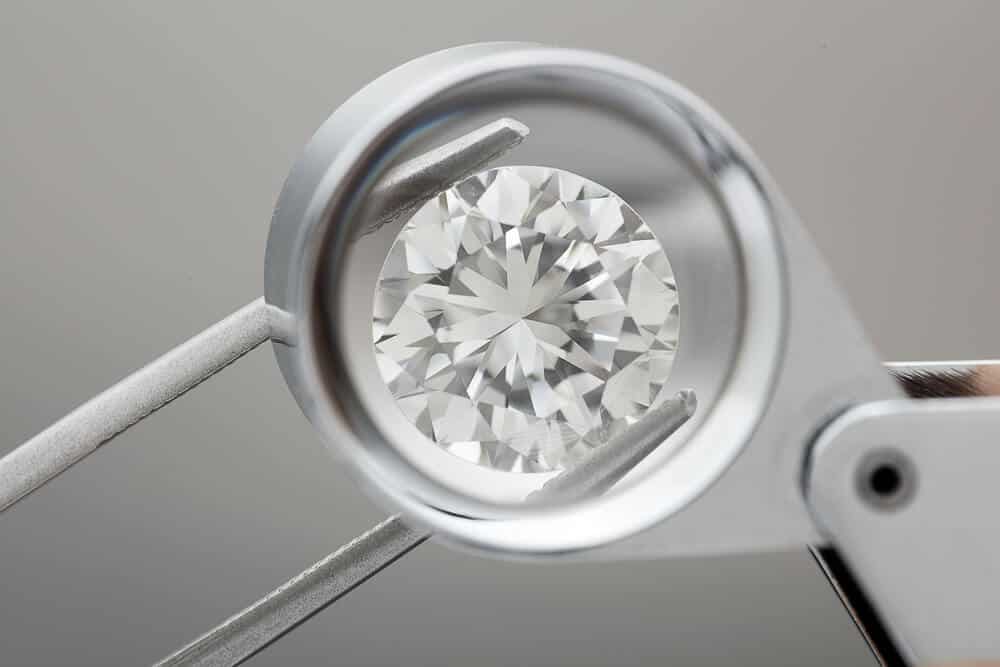
Table of Contents
Choosing the right diamond for your engagement ring requires an understanding of a diamond’s quality factors. It can be quite daunting and difficult to make the right choice, balancing out quality against budget.
This is where the 4cs come in.
The 4cs stand for Cut, Color, Clarity, and Carat. They cover the most important aspects to keep in mind when selecting a diamond. Let’s take a look at these four categories in more detail.
Diamond Cut
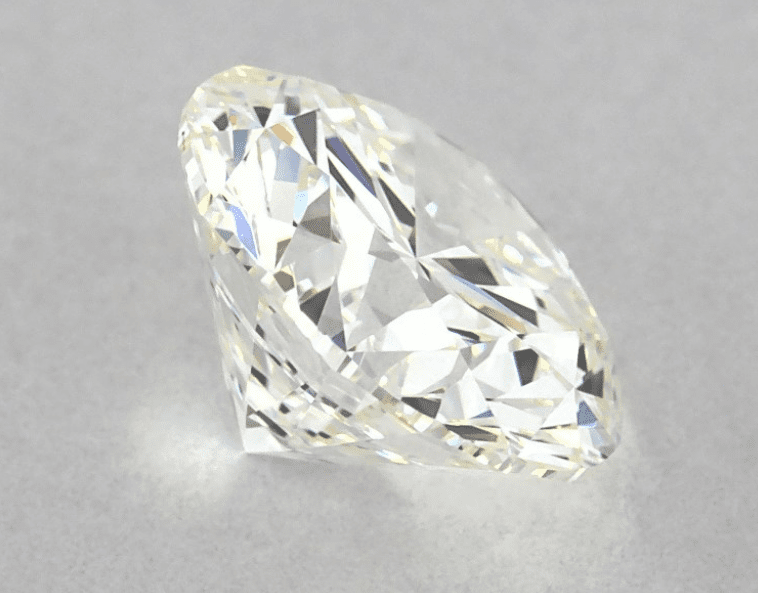
The cut of the diamond is the most important characteristic of the 4C’s. In fact, many say that Cut is King. Cut refers to how a diamond is shaped from the rough, allowing for the best play of light.
If the diamond is cut too shallow, light reaches through the bottom and is faintly reflected; when too deep, light is bent sideways. The best cut will cause the light to reflect back upwards, resulting in maximum brilliance.
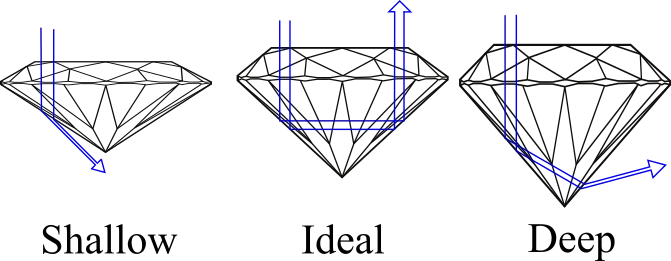
The better the cut, the more the diamond sparkles. In the industry, there are three terms used to describe the effect of light on the diamond.
- Brilliance – this refers to the light that reflects off the diamond. It is what makes the stone appear to sparkle.
- Dispersion – this is when some rays of white light moving through the diamond is broken down into the colors of the spectrum.
- Scintillation – this refers to perceivable colors that flash from the stone when the diamond is moved back and forth.
The GIA’s cut grading is the most widely accepted grading system, with five levels of cut quality: Excellent, Very Good, Good, Fair and Poor.
| Excellent | Contains the highest level of brilliance (reflected white light) and fire (flashes of color). Excellent cuts reflect almost all entering light, creating maximum sparkle. |
| Very Good | Reflects most but not all light entering the diamond. Very similar to the excellent grade. The fire and brilliance is at a high level. |
| Good | Much of the light is reflected giving the diamond a good amount of brilliance and fire. |
| Fair | Fire and brilliance is reduced as majority of light escapes from the diamond. In smaller diamonds, this effect is not as perceivable making it more acceptable. |
| Poor | The diamond appears dull with very little sparkle, as most light travels out through the bottom and sides of the diamond. |
As cut is the most important factor when it comes to colorless diamonds, it’s best not to compromise on the quality. Go as high as your budget allows. Very Good and Excellent cuts are the best options if you can stretch your budget, but it’s recommended not to fall below Good and lower grades.
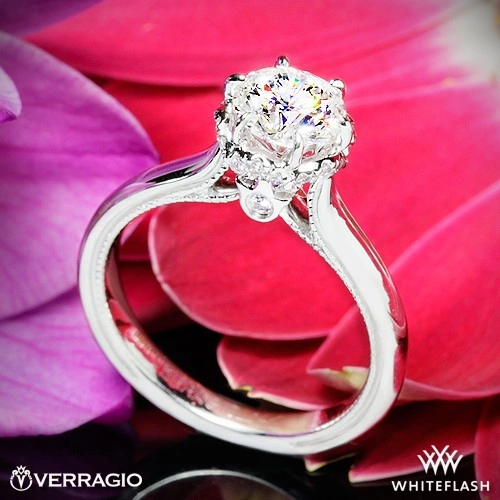
Most major retailers offer a signature cut category. Blue Nile’s best cut category is called ‘Signature Ideal’ while James Allen call theirs ‘True Hearts’. While these are some of the best diamonds, you can still get a stunning diamond with an Excellent grading.
Diamond Color
Color is possibly the second most important of the 4cs. The diamond color grades range from icy white to yellow, with colorless diamonds valued higher. It can be hard to tell a diamond’s color grade from the next, especially without comparing the two diamonds side by side. In general, the less color, the higher the value.
The following chart shows the D-Z color scale.

When evaluating the a diamond’s color, looking at it face up will not give you an accurate idea of its color tone. It’s best to see the stone from the side and the bottom as well. This is where 360 degree videos come in handy when shopping online, as this allows you to see the stone from all angles and at magnification.
While D-E-F grades are colorless, they can also be quite expensive. You can drop as low as H color and still have a great looking diamond. If you’re opting for a yellow or rose gold ring setting, you can drop even further down on the scale without compromising on the look of the ring.
Compare this D color diamond with a similar H color diamond. There is a difference in price of over $600 – the main distinguishing factor between the two stones is color. While the color difference is obvious at magnification, when you look at the two stones side by side, it’s not that visible.
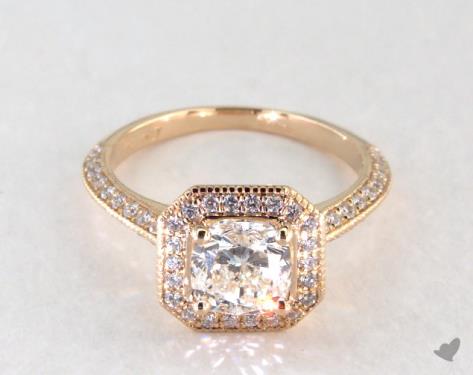
Here are some tips to keep in mind when selecting color.
- The metal of the ring setting will impact the color of the stone. For colorless diamonds, white metals will emphasize the colorlessness. For diamonds with color, rose or yellow gold will blend in beautifully and minimize the tints of the stone.
- The larger the diamond, the more visible the stone. For diamonds of 1 carat or less, the difference between adjacent color grades can be difficult to tell apart.
- Brilliant cuts, like the round, princess, or cushion, can minimize color. This is because these shapes reflect more light (due to having more facets) which makes the color of the diamond less noticeable.
- For the best value of your money choose diamond between G-J grading as these diamonds appear colorless to the naked eye, depending on the size of the stone.
Diamond Clarity
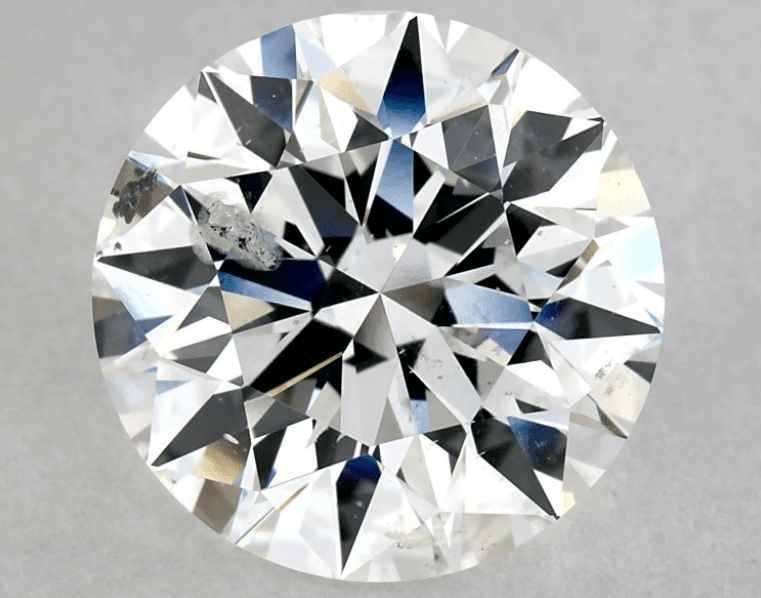
While clarity is an important aspect of the 4cs, it’s also one that doesn’t entirely depend on grading. Clarity refers to the internal purity of the diamond. There are many types of inclusions and blemishes that can impact a diamond’s clarity.
Most inclusions are microscopic that they tend to be invisible unless under 10x magnification by a skilled grader. Examples of inclusions are crystals or minerals that were naturally enclosed by the diamond, feathers, which refer to fractures inside the diamond, cavities, which are spaces left after polishing, and pinpoints which are dust-like structures of crystals that often arrange themselves in clusters.
Blemishes refer to external impurities brought about by wear and tear, the cutting process or the diamond’s natural crystal structure itself. Typical examples include scratches which are thin white lines across the diamond’s table, nicks which look like small chips, abrasion which appears as a series of tiny nicks along a facet corner, and pits which look like tiny dots on the diamond’s surface.
All diamonds are examined under 10x magnification to determine the clarity grade. The fewer impurities there are, the higher the clarity grade of the diamond.
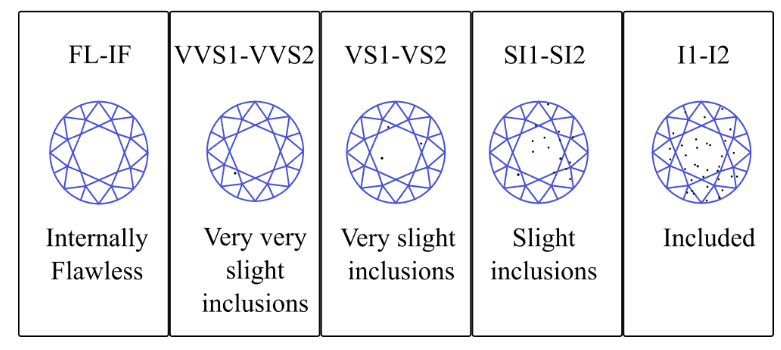
Some jewelry companies undergo clarity enhancement techniques to improve the purity of the diamond. Two common techniques are laser drilling and fracture drilling.
Laser drilling uses laser to cut a small hole into the diamond to reach the visible inclusion inside and treat it or eliminate it.
Fracture drilling uses molten glass to cover up fractures or spaces inside the diamond. Though these techniques are designed to enhance clarity, the marks they leave on the diamond’s surface may very well be considered as blemishes.
When buying your diamond, look for a stone that doesn’t have visible impurities. It should look beautiful without flaws that mar the surface of the stone or interfere with its light performance. For this, make sure you view the actual diamond or high quality imagery of the actual stone prior to buying. Note that the certificate of the diamond will not give you details about the position or appearance of any inclusions.
Diamond Carat
Carat is perhaps the most heard of or talked about and yet the most misunderstood of all the characteristics. Carat refers to the diamond’s weight, not its size. A carat weighs 0.2 grams. To put that into perspective, a 3 carat diamond (which sounds massive!) weighs about the same as a raisin.
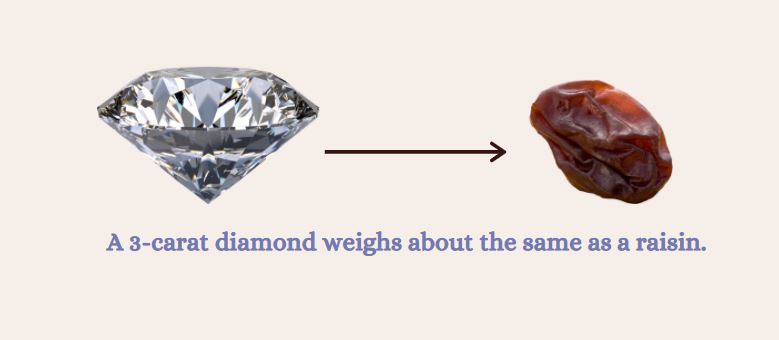
While most people gravitate towards larger carat sizes, size alone doesn’t matter when it comes to diamonds. In fact, if you have to compromise on the 4cs, size is probably the best place to do it.
What does this mean?
Well, if you’re budget only allows either an Excellent cut or a 1 carat stone, we recommend choosing the better cut, and dropping the size down to .80-.95 carats. You won’t notice the size all that much, but you’ll definitely see the difference in sparkle.
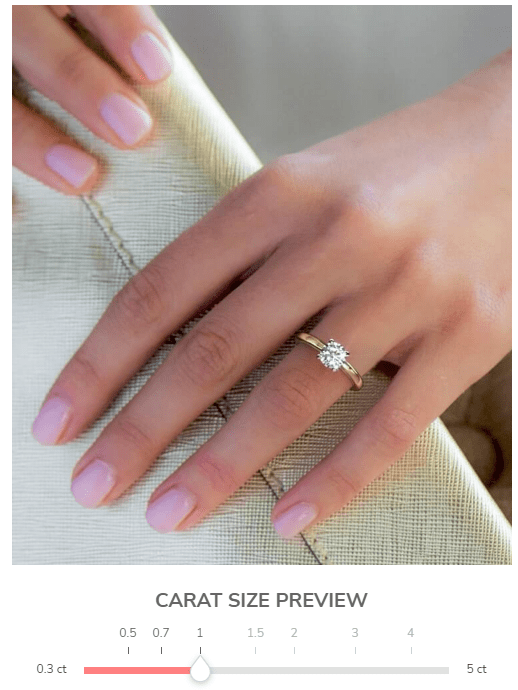
The shape of the stone as well as the size of finger can influence how big the stone appears. For example, a marquise cut diamond will look bigger than a round or princess cut diamond of the same carat size. This is because of its elongated appearance. In the same way, a tiny finger can make a smaller diamond appear larger than a more chubbier finger.
Where to Buy the Best Diamonds
It’s important to purchase your diamond from a reputable and trustworthy retailer to ensure that you’re getting value for your money and not being ripped off.
If purchasing your diamond online, we recommend the following retailers:
Why: Superior diamond imaging, competitive prices, high quality, wide range
An online giant in the diamond space, James Allen a stunning collection of high-quality diamonds. The images and videos are unparalleled in quality and makes shopping online similar, if not better, to shopping in store.
Why: Competitive prices, wide range, great quality
Known for dominating the online diamond industry since the late 1990s, Blue Nile offers one of the largest online diamond inventories. Search diamonds here at competitive prices, solid after-sales policies, and good customer service.
Why: Superior cut quality, exclusive range, stunning designs
Whiteflash has earned an international reputation for the elite quality of their precision cut diamonds, and for their impeccable collection of designer engagement rings. Check their stunning range of diamond jewelry and loose diamonds.
Why: Impeccable quality, superior cut, small but exclusive inventory
Brian Gavin is a renowned expert in diamond cut – and it shows in their superior diamond quality. For the very best in diamonds, search their inventory of designer diamond jewelry and loose diamonds.
Why: Try before you buy, build your own ring, great quality
If you want to try out how a certain diamond ring looks on your finger before you commit to buying one, check out With Clarity’s Home Preview Service which is completely free. Find out more here.
Wrapping Up
Studying the elements that make up the diamond can be exhausting. But with the right information, you are sure to make good and informed decisions.
At the end of the day, it all ends up to your preference over cut, clarity, color and carat. Choose that mix that fits your budget and best suits your style.
Considering the 4C of diamonds, we have developed a very easy step by step guide on how to choose your diamond for your engagement ring. This, will help you to choose the best diamond for your engagement ring especially if you are shopping on a tight budget.









